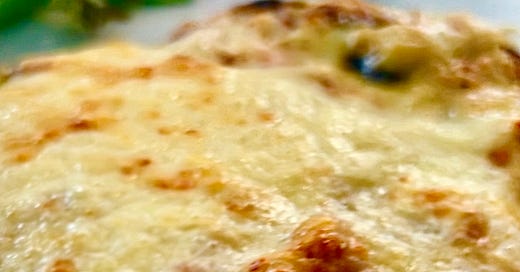The Many Lives of Chicken Parmigiana
... how one dish can make itself at home in so many different places. Plus, a bubbling, saucy and slightly unusual version of this utterly delicious and indulgent classic.
Few dishes inspire as much regional name quirkery as chicken parmigiana. Depending on where you find yourself, this crispy, breaded, cheesy plate of gorgeousness might be called chicken parm, chicken parma, parmi, Pollo alla Parmigiana, chicken parmesan, parmy and probably many more names besides. Actually, these are more than linguistic peculiarities. Names matter because they reveal things about regional pride, or even a fight for culinary recognition.
I think about ‘parmy’ a lot—probably because I grew up in Australia, a land deeply devoted to bashed out chicken fillets, crumbed, fried and topped with tomato sauce and melted cheese. It seemed to become a staple of Australian pub culture in Sydney during the 1990s, coinciding with the rise of leagues clubs and RSLs, where enormous, affordable meals were a major draw. Parmy always brings back memories of family seaside holidays—our sunburned, sandy posse drifting in from the beach to devour colossal platefuls (honestly, the size of my head), washed down with schooners of lemonade. The icy blast of air-con, live rugby league and horse racing blaring from big screens, and the chirrup of pokies were the soundtracks to our parmy feasts.
The dish is often thought of as an Italian-American staple but, as ever, its origins are tangled. The dish evolved from the Italian tradition of layering aubergine with tomato sauce and cheese—melanzane alla parmigiana. Italian immigrants in the US, Canada, and Australia adapted it, swapping aubergine for breaded chicken (or sometimes veal). But despite its Italian roots, you’ll get a blank stare if you try ordering it in Italy, apparently.
In the US, ‘chicken parm’ or just Parm is also deeply woven into home cooking and restaurant culture; a favourite on old-school Italian-American menus, a comfort meal for families, and a go-to filling for subs at delis and diners. There are soooo many iterations in the New York Times, mostly involving a tomato sauce of some kind nestled among the layers.
Which brings me to Teesside, a region in the northeast of England, centred around the town of Middlesbrough, where the dish takes on a whole new identity—the Teesside Parmo. It’s a true local treasure that swaps mozzarella for a gooier béchamel sauce - no tomato sauce, thanks - and served with chips and salad (though the salad is often neglected in favour of more chips).
Some trace its working class roots in Teesside to a particularly inventive and famished soul after a big night out on the lash. More likely, it came via a US soldier who settled in the area after World War II, and turned the dish into a late-night takeaway staple that went on to become a local obsession, the subject of competitive eating challenges and several social media fan pages.
A few years back, Teesside’s mayor applied for the ‘Teesside Parmo’ to be awarded geographical indication status, akin to the Neapolitan pizza, which won its Traditional Specialty Guaranteed (TSG) mark in 2009. Teesside’s bid appears to have fizzled out. Surely, it can’t have been a publicity stunt by Mr Mayor, could it? Regardless, I would like to see Teesside win its case. Its Parmo isn’t just a regional version of chicken parmigiana; it’s a distinct entity, tied to a specific place and its people, as well as being delicious. Which brings me to this week’s recipe, my take on the Teesside Parmo.
As all good parm’s do, this one starts with breaded and fried chicken fillets ,and then goes off-piste a bit in the most glorious way. Chicken parm, but unmistakably Teesside, especially served with chips.
Keep reading with a 7-day free trial
Subscribe to Pen and Spoon to keep reading this post and get 7 days of free access to the full post archives.





